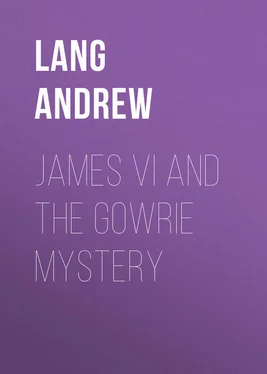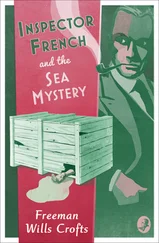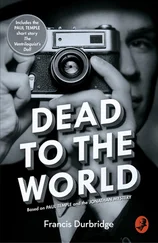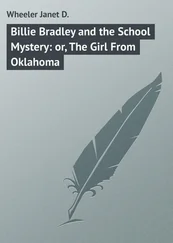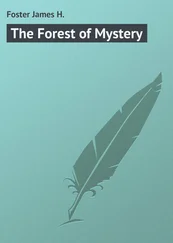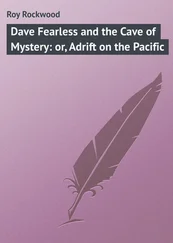Andrew Lang - James VI and the Gowrie Mystery
Здесь есть возможность читать онлайн «Andrew Lang - James VI and the Gowrie Mystery» — ознакомительный отрывок электронной книги совершенно бесплатно, а после прочтения отрывка купить полную версию. В некоторых случаях можно слушать аудио, скачать через торрент в формате fb2 и присутствует краткое содержание. Жанр: foreign_antique, foreign_prose, на английском языке. Описание произведения, (предисловие) а так же отзывы посетителей доступны на портале библиотеки ЛибКат.
- Название:James VI and the Gowrie Mystery
- Автор:
- Жанр:
- Год:неизвестен
- ISBN:нет данных
- Рейтинг книги:5 / 5. Голосов: 1
-
Избранное:Добавить в избранное
- Отзывы:
-
Ваша оценка:
- 100
- 1
- 2
- 3
- 4
- 5
James VI and the Gowrie Mystery: краткое содержание, описание и аннотация
Предлагаем к чтению аннотацию, описание, краткое содержание или предисловие (зависит от того, что написал сам автор книги «James VI and the Gowrie Mystery»). Если вы не нашли необходимую информацию о книге — напишите в комментариях, мы постараемся отыскать её.
James VI and the Gowrie Mystery — читать онлайн ознакомительный отрывок
Ниже представлен текст книги, разбитый по страницам. Система сохранения места последней прочитанной страницы, позволяет с удобством читать онлайн бесплатно книгу «James VI and the Gowrie Mystery», без необходимости каждый раз заново искать на чём Вы остановились. Поставьте закладку, и сможете в любой момент перейти на страницу, на которой закончили чтение.
Интервал:
Закладка:
Some of their party were in the street, and seeing an altercation in which two of the King’s gentlemen were prevented from seizing Gowrie, they made an ineffectual effort to capture the Earl. Gowrie ran from them along the street, and there ‘drew his two swords out of one scabbard,’ says Cranstoun. 10 10 Cranstoun’s deposition in Pitcairn, ii. 156, 157. At Falkland August 6.
The Earl had just arrived in Scotland from Italy, where he had acquired the then fashionable method of fencing with twin-swords, worn in a single scabbard. Gowrie, then, had retreated from the Murrays to the house of one Macbreck, as Cranstoun and Macbreck himself declared. Cranstoun too drew his sword, and let his cloak fall, asking Gowrie ‘what the fray was.’ The Earl said that ‘he would enter his own house, or die by the way.’ Cranstoun said that he would go foremost, ‘but at whom should he strike, for he knew not who was the enemy?’ He had only seen the Erskines collar Gowrie, then certain Murrays interfere, and he was entirely puzzled. Gowrie did not reply, and the pair advanced to the door of the house through a perplexed throng. A servant of Gowrie’s placed a steel cap on his head, and with some four or five of Gowrie’s friends (Hew Moncrieff, Alexander Ruthven, Harry Ruthven, and Patrick Eviot) the Earl and Cranstoun entered the front court.
Here Cranstoun saw the body of a man, whether dead or wounded he knew not, lying at ‘the old turnpike door,’ the entry to the dark narrow staircase up which Ramsay had run to the King’s rescue. ‘Who lies there?’ asked Cranstoun. Gowrie only replied, ‘Up the stair!’ Cranstoun led the way, Gowrie came next; the other four must have followed, for several witnesses presently saw them come down again, wounded and bleeding. Cranstoun found Erskine, Ramsay, and Herries with drawn swords in the chamber. The King, then in the turret, he did not see. He taunted Herries; Ramsay and Gowrie crossed swords; Cranstoun dealt, he says, with Herries, Erskine, and perhaps Wilson. But, though Cranstoun ‘nowise knew who followed him,’ the four men already named, two Ruthvens, a Moncrieff, and Eviot, were in the fray, though there was some uncertainty about Eviot. 11 11 The adversaries of the King say that these men ran up, and were wounded, later , in another encounter. As to this we have no evidence, but we have evidence of their issuing, wounded, from the dark staircase at the moment when Cranstoun fled thence.
The position of the King, at this moment, was unenviable. He was shut up in the little round turret room. On the other side of the door, in the chamber, swords were clashing, feet were stamping. James knew that he had four defenders, one of them a lame medical man; who or how many their opponents might be, he could not know. The air rang with the thunder of hammers on the door of the chamber where the fight raged; were they wielded by friends or enemies? From the turret window the King could hear the town bell ringing, and see the gathering of the burgesses of Perth, the friends of their Provost, Gowrie. We know that they could easily muster eight hundred armed men. Which side would they take? The Murrays, as we saw, had done nothing, except that some of them had crowded round Gowrie. Meanwhile there was clash of steel, stamping of feet, noise of hammers, while the King, in the turret, knew not how matters were going.
Cranstoun only saw his own part of the fight in the chamber. How Ramsay and Gowrie sped in their duel he knew not. Ramsay, he says, turned on him , and ran him through the body; Herries also struck him. Of Gowrie he saw nothing; he fled, when wounded, down the turret stair, his companions following or preceding him. Gowrie, in fact, had fallen, leaving Ramsay free to deal with Cranstoun. Writers of both parties declare that Ramsay had cried to Gowrie, ‘You have slain the King!’ that Gowrie dropped his points, and that Ramsay lunged and ran him through the body. Erskine says that he himself was wounded in the right hand by Cranstoun; Herries lost two fingers. When Ramsay ran Gowrie through, the Earl, says Erskine, fell into the arms of a man whom he himself knew not; Gowrie’s party retreated, but it seems they returned to the head of the narrow staircase, and renewed hostilities by pushing swords and halberts under the narrow staircase door. This appears from the evidence of Lennox.
After pounding at the door so long, Lennox’s party at last sent Robert Brown (a servant of James’s, who had brought the hammers) round to discover another way of reaching the King. Brown, too, now went up the narrow staircase, and in the gallery chamber he found the King, with Herries, Erskine, Ramsay, Wilson, and the dead Earl. He reassured James; the hammerers were his friends. They handed, says Lennox, one of the hammers to the King’s party, through a shattered panel, ‘and they within broke the doors, and gave them entry.’ At this time, halberts and swords were being struck, by Gowrie’s retainers, under the door, and through the sides of the door, of the chamber; this door apparently being that from the chamber to the narrow staircase. Murray of Arbany (who had come into the house at the end of dinner) was stricken through the leg by one of these weapons. Deacon Rhynd of Perth saw Hew Moncrieff striking with ‘a Jeddart staff,’ a kind of halbert. A voice, that of Alexander Ruthven (a cousin of the fallen Earl), cried ‘For God’s sake, my lord, tell me how the Earl of Gowrie does.’ ‘He is well. Go your way; you are a fool; you will get no thanks for this labour,’ answered Lennox, and all was silence. Alexander Ruthven and the rest retreated; Ruthven rushed to the town, rousing the people, and rifling shops in search of gunpowder. The King and the nobles knelt in prayer on the bloody floor of the chamber where the dead Gowrie lay. For some time the confused mob yelled outside, shaking their fists at the King’s party in the window: men and women crying ‘Come down, Green-coats, ye have committed murder! Bloody butchers!’ Others cried ‘The King is shot!’ The exits of the house were guarded by retainers of Gowrie – Rentoul, Bissett, and others.
Mar and Lennox, from the window, explained to the mob that the King was well. James showed himself, the magistrates and nobles pacified the people, who, some armed, some unarmed, were all perplexed, whether they were anxious about the King or about their Provost, the Earl. From the evidence of scores of burghers, it appears that the tumult did not last long. One man was reaping in the Morton haugh. Hearing the town bell he hastened in, ‘when all the tumult was ceased,’ and the magistrates, Ray and others, were sending the people to their houses, as also did young Tullibardine. A baker, hearing the bell, went to the town cross, and so to Gowrie’s house, where he met the stream of people coming away. Another baker was at work, and stayed with his loaves, otherwise he ‘would have lost his whole baking.’ The King represents that it was between seven and eight in the evening before matters were quiet enough for him to ride home to Falkland, owing to the tumult. The citizens doubtless minimised, and James probably exaggerated, the proportions and duration of the disturbance.
This version of that strange affair, the slaughter of the Ruthvens, is taken entirely from the lips of sworn witnesses. We still know no more than we did as to what passed between the moment when James and the Master, alone, left the dining chamber, and the moment when the King cried ‘Treason!’ out of the turret window.
The problem is, had James lured the Master to Falkland for the purpose of accompanying him back to Perth, as if by the Master’s invitation, and of there craftily begetting a brawl, in which Gowrie and the Master should perish at the hands of Ramsay? Or had the Master, with or without his brother’s knowledge, lured James to Perth for some evil end? The question divided Scotland; France and England were sceptical as to the King’s innocence. Our best historians, like Mr. Hill Burton and Mr. Tytler, side with the King; others are dubious, or believe that James was the conspirator, and that the Ruthvens were innocent victims.
Читать дальшеИнтервал:
Закладка:
Похожие книги на «James VI and the Gowrie Mystery»
Представляем Вашему вниманию похожие книги на «James VI and the Gowrie Mystery» списком для выбора. Мы отобрали схожую по названию и смыслу литературу в надежде предоставить читателям больше вариантов отыскать новые, интересные, ещё непрочитанные произведения.
Обсуждение, отзывы о книге «James VI and the Gowrie Mystery» и просто собственные мнения читателей. Оставьте ваши комментарии, напишите, что Вы думаете о произведении, его смысле или главных героях. Укажите что конкретно понравилось, а что нет, и почему Вы так считаете.
